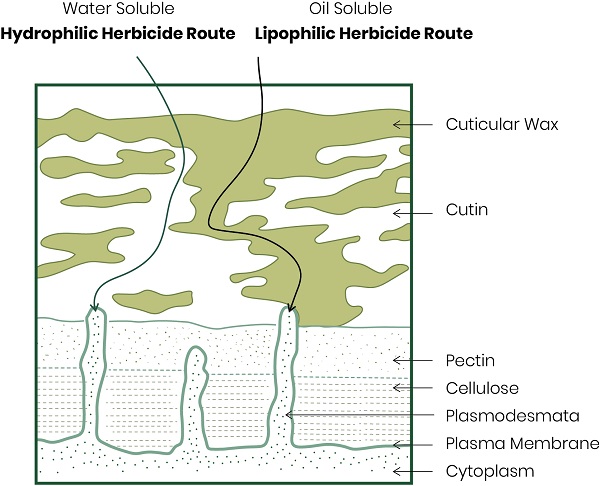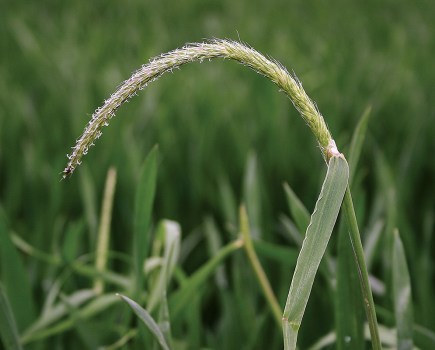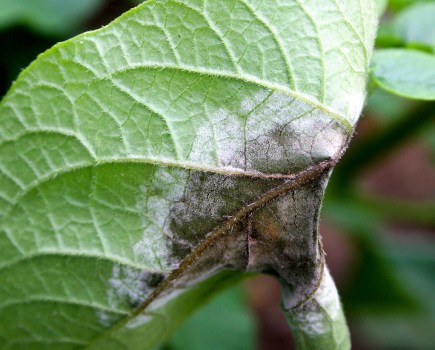Weed control this spring is likely to be a little more challenging than normal after the wet and relatively mild winter, so the launch of a new adjuvant for use with post-emergence herbicides may just help herbicides hit their mark. CPM finds out more.
Trials have shown significant increases in the speed of kill.
By Lucy de la Pasture
Sorrento may be best known for its Mediterranean climate and the delicious limoncello it produces, but the Italian town also lends its name to a new adjuvant from specialist company Interagro. Its novel formulation is specifically designed to facilitate the performance of post-emergence herbicides, giving weeds ‘the kiss of death’.
Treating weeds at the post-emergence timing can pose a particular set of challenges, explains Sarah Ferrie, marketing manager at Interagro, but Sorrento has been engineered specifically to overcome them. “A post-em herbicide must come into contact with the weed and then be retained long enough on the leaf surface to penetrate and be absorbed into the plant.

The rate of movement of water-soluble herbicides into the leaf is slow, so less herbicide is absorbed by weeds.
“Once in the plant, the active ingredient must then reach the target site inside the leaf tissue where it can disrupt a vital process or structure – the exact process or structure depending on the herbicide’s mode of action,” she explains.
So what’s the biggest barrier to effective weed control? It’s the cuticle on the leaves of weed plants, explains Sarah.
“Herbicides have to penetrate the leaf cuticle to travel to their target site. It’s a barrier present on both the upper and lower leaf surfaces to protect plant against water loss.”
The cuticle is made of three types of materials – wax, cutin and pectin. Wax is on both the leaf surface and inside the cuticle layers. It’s made up of long hydrocarbon chains, including fatty acids, and forms a water repellent layer over the entire leaf surface, restricting entry of water-soluble compounds.
The cutin layer is made up of intermediate length chains of fatty acids and is interspersed with pectin strands, which are also present at the cell wall interface. When hydrated, pectin strands provide aqueous pathways, enabling the uptake of water-soluble herbicides, she explains.
“Water is the most commonly used carrier for herbicides because it is cheap and readily available. But water has a high surface tension and therefore doesn’t spread out on waxy surfaces. As a result, aqueous herbicide solutions can frequently bounce off or run off the leaf.”
Hairy weeds, such as cranesbill, can be even more challenging to control because this ‘beading’ can occur when the droplet lands on the leaf.
“The spray droplet can be suspended by the hairs on the leaf, preventing it from spreading out in the same way as in waxy weeds, such as fat hen, where the leaves are hard to coat with herbicide because they repel water.”
These are problems that can be overcome by adding a suitable adjuvant to the tank which will reduce the surface tension of spray droplets, so that they can spread out on the leaf surface and enable the herbicide to get into the weed at the maximum number of entry points.
The question you’re probably asking yourself right now is surely herbicides are formulated to overcome these problems? Sarah says that to some extent this is true, but there are limits to how much improvement to spreading, retention and uptake can be made within a herbicide formulation.
“When a herbicide is added to the tank, the volume of adjuvant used is based on the herbicide rate/ha, not the water volume. In spray applications, the water volume used can be anything from 80-200 l/ha, or even 400 l/ha in high volume spraying,” she comments.
With this in mind, Sarah argues that only tank-mix adjuvants can deliver fully optimised wetting, spreading and retention, because the adjuvant rate can be adjusted for each application based on total water volume being applied.
Having achieved an even distribution on the surface of weed leaves, the next hurdle is entry. Interagro’s technical manager Stuart Sutherland takes up the story.
“The ability to penetrate the cuticle is determined by a herbicide active’s chemical make-up. Herbicides are either predominantly water soluble (hydrophilic) or predominantly oil soluble (lipophilic),” he explains.
“Herbicides which are more lipophilic are able to penetrate the cuticle barrier by simple diffusion through the waxy components. The rate of movement of the ‘more’ water-soluble herbicides (which a lot of post-em herbicides are) is much less, due to their low solubility in the waxy cuticle, and this results in less herbicide being absorbed by weeds.”
Because of this, herbicides with a moderate to high solubility in water need a more hydrophilic surfactant to penetrate the waxy cuticle to increase the flow rate of herbicide into the leaf. In effect, it’s like increasing the speed on a motorway – it increases the flow of traffic, explains Stuart.
“Looking at water solubility of the herbicide is a good indicator of the need for an adjuvant to improve herbicide performance. The pesticide properties database is a good reference and shows that a lot of herbicide actives used post-em, resist cuticle penetration so could be helped by using a suitable adjuvant (see table 1).
So, what about herbicides with low water solubility? Can they penetrate the leaf cuticle?
“Yes, these herbicides can easily penetrate the cuticle by simple diffusion through the lipophilic components. Herbicide uptake can still be improved, but with a more lipophilic adjuvant (such as Kantor), which is able to increase fluidity of waxes in the cuticle. That’s like creating more lanes on a motorway to increase the flow of traffic,” he says.
Sorrento has been extensively tested in replicated field trials over the past four seasons, proving to enhance herbicide performance in 51 of the 52 trial comparisons, points out Stuart.
“In 33% of the comparisons, the Sorrento benefit was statistically significant. With Ally Max (metsulfuron-methyl), which has high solubility in water, the benefit from the addition of Sorrento was impressive. Even at full rate (42 g/ha Ally Max), its overall control of fumitory was improved by 42% against a population of 68 plants/m2.
“Given the lack of chemistry in barley to control grassweeds, we’ve also looked at Sorrento with Axial Pro (pinoxaden), which has moderate solubility in water, to control ryegrass and wild oats. Trials have shown significant increases in the speed of kill, with improvements in overall weed control of +10% by the end of the season,” he comments.
Further work at Fera Science in Yorkshire has confirmed that Sorrento improves coverage and uptake, increasing speed of kill. Growth reduction, reddening & meristem growth inhibition were all much faster using Sorrento, he adds.
Sorrento has also been developed with the environment and users in mind, says Sarah. “It has low aquatic toxicity and is biodegradable, with a low odour and a dose rate of just 0.1% of the total spray volume. That makes it a very ‘clean’ and user-friendly addition to the new generation of adjuvants from Interagro.
“With fast solvency power, it also helps actives to dissolve in water faster, even when spray water is cold which can be a challenge at the early spring and late autumn timings,” she says.
In practice herbicides are seldom applied alone, particularly in the spring when there are a lot of bases to cover. Will Sorrento help those too? Sarah believes it will, based on their work to date.
“The spreading and retention of other pesticides will certainly be helped by Sorrento. Most pesticides experience high surface tension in water, so Sorrento will help coverage. We’ve also seen improvements in yield in some fungicide trials, for example with Librax (metconazole+ fluxapyroxad) and Elatus Era (benzovindiflupyr+ prothioconazole) at the T3 timing.
“So, whilst Sorrento will deliver the biggest improvements in weed control with more water-soluble actives, it’s still beneficial across the whole tank-mix,” she concludes.
Improved grassweed control seen in trials
With plenty of planting still to be done, spring is looking like it’s going to be even busier than normal. The winter cereals in the ground have received varying amounts of residual herbicide, which may well have run out of steam earlier than the norm after months of excess rainfall, allowing late-germinating grassweeds through. It all adds up to a greater reliance on spring-applied contact herbicides than in a more average season, says Agrii regional technical advisor, Will Foss.
“Germination of grassweeds has been pushed later for a variety of reasons this season, so there could be a bigger flush of spring-germinating grassweeds than usual,” he says.
Agrii field trials have been looking at the performance of Sorrento for the past two seasons and have seen a benefit where it’s been applied.
“We see Sorrento as a partner to Axial Pro (pinoxaden), for control of wild oats and ryegrass in wheat and barley crops, having seen some efficacy benefits in our trials,” Will explains.
Even though Axial Pro is the evolution of Axial and now contains its own wetting system, no longer relying on the addition of the adjuvant, Adigor (methylated rapeseed oil), Agrii trials have demonstrated an uplift in control of both grassweed species.
“We made an early assessment of weed ground cover post-application and in ryegrass found a 20% improvement in ryegrass control in 2018 and 39% in 2019. Later in the season we carried out final weed head counts which worked out at a 4% increase in control in 2018 and 1% in 2019,” he explains.
A similar effect was seen with wild oats, where there was a 12% improvement at the early assessment which equated to a 3% overall increase in control at the final head count.
“The results show that the biggest effect from adding Sorrento to Axial Pro is the speed of effect, with a marked increase in weed kill at the early assessment timing. This means weed competition is reduced much more quickly, bringing benefits to the crop,” says Will.
Failure to control grassweeds effectively is often because the weeds are too big at application. Will highlights that if the weed growth stage is wrong or it’s resistant to herbicides, then the addition of Sorrento to the mix won’t overcome these issues.
“Catching grassweeds before stem extension is the best timing in the spring. Left later then control will be hit and miss, as you often see when wild oats are targeted too late. It may well be a spring where there are more late-germinating grassweeds than normal because of the lack of residual that went on in the autumn.”
Where the addition of an adjuvant becomes more important is when application is sub-optimal, he points out. “Often water volumes are below the 200 l/ha, which is ideal, and weed coverage may be compromised. Agrii work has also shown flat-fan nozzles provide better spray distribution than air-induction nozzles, so nozzle selection is also important,” he says.
“This is where Sorrento can really make a difference because of the way it works – decreasing the surface tension of the spray droplet, improving spreading on the weed leaf and enhancing the uptake of the chemistry.”
Sorrento summary
- Designed specifically for use with post-emergence herbicides.
- Optimised for herbicides with moderate-high solubility in water.
- Use at 0.1% of total spray volume.
- Recommended for use in cereals, oilseed rape and maize.
Pushing performance
At the heart of good crop production lies careful use of chemistry to protect the plant and maintain performance, right through the season. But optimising the efficacy of plant protection products can be challenging, while increasingly restrictive regulations limit just how far you can go.
This series of articles explores the science behind the use of adjuvant and biostimulant tools to help power both chemistry and crop performance, as well as increase understanding of why they’re needed and what they do. We’re setting out to empower growers and drive crops to reach their full potential.
CPM would like to thank Interagro for kindly sponsoring this article, and for providing privileged access to staff and material used to help put the article together.
Sorrento is the latest innovation in adjuvant technology designed to power the performance of post-emergence herbicides, leading to faster and more effective weed control in a wide range of crops. Improvements in herbicide spreading and outstanding retention, even on waxy and hairy weeds, results in well-coated leaves. Enhanced cuticle penetration leads to superior delivery to the site of action inside leaf tissue. Sorrento is available to purchase for the first time this spring, exclusively through Agrii.




